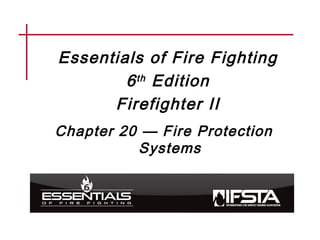EFF I Chapter20
- 1. Essentials of Fire Fighting 6th Edition Firefighter II Chapter 20 â Fire Protection Systems
- 2. Describe fire alarm systems. Learning Objective 1 20â2
- 3. Fire alarm systems alert occupants and other parties of an emergency condition. 20â3
- 4. Alarm systems consist of several components you should know about. 20â4 (Cont.) CourtesyofRonMoore,McKinney(TX)FireDepartment
- 5. There are several alarm system components firefighters should know. 20â5 (Cont.) CourtesyofRonMoore,McKinney(TX)FireDepartment
- 6. There are several alarm system components firefighters should know. 20â6 (Cont.)
- 7. There are several alarm system components firefighters should know. 20â7 (Cont.)
- 8. There are several alarm system components firefighters should know. 20â8
- 9. REVIEW QUESTION What are the basic components of an alarm system? 20â9
- 10. There are several types of alarm signaling systems in use. 20â10 (Cont.)
- 11. There are several types of alarm signaling systems in use. 20â11
- 12. REVIEW QUESTION How do protected premises and station alarm systems differ? 20â12
- 13. Identify alarm initiating devices. Learning Objective 2 20â13
- 14. Alarm-initiating devices send a signal to the alarm system when fire is present. 20â14
- 15. Pull stations allow occupants to initiate the fire signaling system. 20â15
- 16. Heat detectors activate when temperatures in monitored area reach a predetermined point. 20â16
- 17. There are several types of fixed- temperature detectors. 20â17 (Cont.)
- 18. 20â18 There are several types of fixed- temperature detectors.
- 19. Rate-of-rise detectors signal when temperatures rise quickly. 20â19
- 20. There are several types of rate-of-rise detectors. 20â20
- 21. Smoke detectors and alarms both detect the presence of products of combustion. 20â21
- 22. Photoelectric smoke detectors can respond more quickly than ionization- type. 20â22
- 23. Ionization smoke detectors react to ionized molecules in the chamber. 20â23
- 24. There are several types of power sources used for these devices. 20â24
- 25. The basic types of flame detectors detect light in different spectrums. 20â25
- 26. Flame detectors are among the fastest to respond, even in non-fire conditions. 20â26
- 27. Fire-gas detectors operate by detecting gases that may be released. 20â27
- 28. Combination detectors combine various systems into a single device. 20â28
- 29. REVIEW QUESTION What are the major categories of alarm-initiating devices? 20â29
- 30. Explain the ways automatic sprinkler systems work. Learning Objective 3 20â30
- 31. Automatic sprinkler systems are an integrated system of pipes, sprinklers, and control valves. 20â31
- 32. There are two general types of automatic sprinkler systems. 20â32 CourtesyoftheU.S.Navy
- 33. Understanding sprinkler systems also requires other information. 20â33
- 34. Sprinkler systems have several effects on life safety during a fire. 20â34
- 35. Sprinkler systems are made up of several components. 20â35
- 36. Sprinklers are fixed spray nozzles that operate to discharge water. 20â36
- 37. All of the common release mechanisms for sprinklers respond to heat. 20â37
- 38. Sprinkler deflectors create the discharge pattern of water downward. 20â38
- 39. Sprinkler storage cabinets are usually installed near a riser or valve. 20â39 CourtesyofRonMoore,McKinney(TX)FireDepartment
- 40. Most system main water control valves are indicating valves. 20â40
- 41. There are other operating valves also used on sprinkler systems. 20â41
- 42. Waterflow alarms initiate when water begins to flow in the system. 20â42
- 43. The water supply for a sprinkler system must address several considerations. 20â43 (Cont.) CourtesyofRonMoore,McKinney(TX) FireDepartment
- 44. The water supply for a sprinkler system must address several considerations. 20â44
- 45. REVIEW QUESTION What are the fundamental aspects of a sprinkler system? 20â45
- 46. Each type of sprinkler system requires understanding of several concepts. 20â46 (Cont.)
- 47. Each type of sprinkler system requires understanding of several concepts. 20â47 (Cont.)
- 48. Each type of sprinkler system requires understanding of several concepts. 20â48 (Cont.)
- 49. Each type of sprinkler system requires understanding of several concepts. 20â49 (Cont.)
- 50. Each type of sprinkler system requires understanding of several concepts. 20â50
- 51. Residential sprinkler systems require understanding of several concepts. 20â51
- 52. REVIEW QUESTION How do the application methods for sprinkler systems differ? 20â52
- 53. Describe standpipe and hose systems. Learning Objective 4 20â53
- 54. Standpipe and hose systems are designed for a specific purpose. 20â54
- 55. Standpipe systems are made up of several components. 20â55
- 56. Standpipe systems are regulated by two NFPAÂŪ standards. 20â56
- 57. Standpipe systems are classified in three different groups. 20â57
- 58. There are several types of standpipe systems you should know about. 20â58 (Cont.)
- 59. There are several types of standpipe systems you should know about. 20â59
- 60. REVIEW QUESTION How are standpipe systems classified? 20â60
- 61. Explain the ways smoke management systems work. Learning Objective 5 20â61
- 62. Smoke management systems remove and/or control the spread of smoke. 20â62
- 63. Smoke control strategies use various methods to remove smoke. 20â63
- 64. Each type of smoke control systems may be dedicated or non-dedicated. 20â64
- 65. The firefightersâ smoke control station provides a location for monitoring. 20â65
- 66. REVIEW QUESTION What types of smoke control systems can be used at an incident? 20â66
- 67. âĒ Many buildings are protected, partially or fully, by fire protection systems that range from simple to complex. âĒ These systems can perform a variety of functions and it is important that these are identified during preincident surveys to ensure firefighters understand how to operate in these structures. Summary 20â67



































































